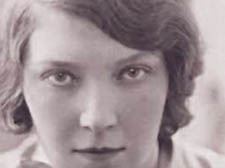|
|
 |
| |

Jean Rhys in her youth |
A portrait of the modernist as a young woman
Lilian Pizzichini explains how the courage shown by author
Jean Rhys, both in her private life and in her work, inspired her
to write a biography
The Blue Hour: A Portrait of Jean Rhys
By Lilian Pizzichini. Bloomsbury
IN the summer of 1912 Jean Rhys’s lover, a wealthy gentleman banker called Lancelot Grey Smith, moved her into a suite of rooms on Chalk Farm Road. Jean – who would go on to write the classic novel Wide Sargasso Sea about the first Mrs Rochester in Charlotte Bronte’s Jane Eyre – had arrived in London from a lush Caribbean island five years previously, aged 17.
She was a white Dominican from an impoverished slave-owner’s family and had come to England to complete her education. She had chosen to be a chorus girl instead of returning home, and Chalk Farm was her first taste of English domesticity.
The rooms were large with high ceilings. She had a piano and sofa, a table and chairs. She sat at the window all day watching the street hustlers selling their wares and singing their songs.
She was a dreamer, and she breathed in this lively street scene, as though in absorbing it she would keep it forever. She spent all day like this, waiting for her lover’s driver, who would take her to dine with her beloved at the Ritz or the Savoy.
By the end of summer, the affair was waning and the air in Chalk Farm seemed fetid. Jean would venture outside for a stroll, aware of other pedestrians all breathing the same air as herself – as though they were all gasping for the same breath.
Jean did not stay in Chalk Farm for long; her lover tired of her and, in despair, she took to the streets of the West End.
She lodged with a phony masseuse off Oxford Street, and hooked up with a former chorus girl who had turned to prostitution as a more lucrative means of survival.
London was not a happy place for Jean. It was too cold and bewildering, too hard. Her lover still supported her financially but they were both relieved when she finally met a man who married her and took her away to Paris.
This was in 1919, and Jean would spend the next 10 years trailing after her vagabond husband, lurching from one disaster to another, writing all the while. It was in Paris that she met the novelist Ford Madox Ford.
Madox Ford persuaded her to write and the first thing she wrote about was her doomed love affair with an English gentleman, and waiting for him to send for her while she stared out of the window on to Chalk Farm Road. Then she wrote a novel set in Paris. It was based on her love affair with Madox Ford and her strained relationship with his angry wife and her angry husband.
She wrote short stories about being a chorus girl, about her childhood in Dominica, about inter-war Paris and Vienna. She turned her life into sharp, modernistic fiction that stunned her readers. They were not ready for her.
Jean Rhys was powerless over people, places and things, and would feel this disappointment throughout her life most keenly. But she found her power in writing. Her courage and her talent for leading an unconventional life inspired me to write her biography.
The next time Jean would come back to this neck of north London’s woods was on June 27, 1949, when she was sentenced to five day’s imprisonment in Holloway Prison. She was 59 years old.
She had lived through two world wars, given birth to two babies, one of whom died in infancy, the other of whom lived on another continent. She had been married three times and had four novels published.
She was in prison because her neighbour’s dog had killed her cat – about whom she had written a poem. Her quarrel with her neighbour escalated into all-out war. Jean drank herself into being the scourge of suburbia, until they could take it no more and she was remanded in custody.
At night she could hear another prisoner in the punishment block singing a song. The singer was singing: “the girls cheerio and never say die”. Jean wrote a short story based on her time in Holloway. Let Them Call It Jazz tells the story of a woman from the Caribbean who is out of her depth in an urban landscape.
But she never says die, and Jean kept writing.
|
 |
|
 |
 |
|
 |
|


